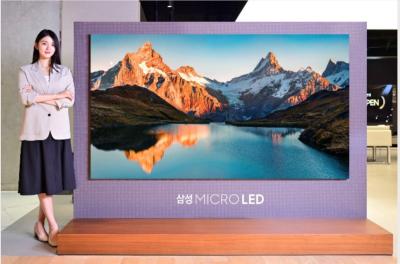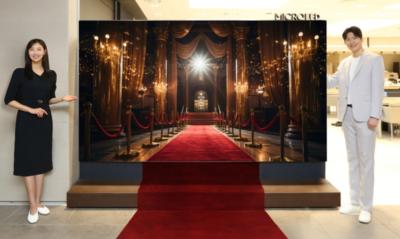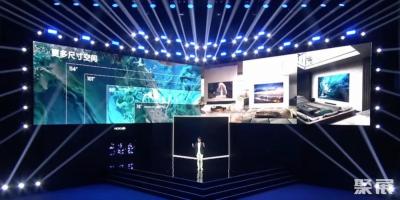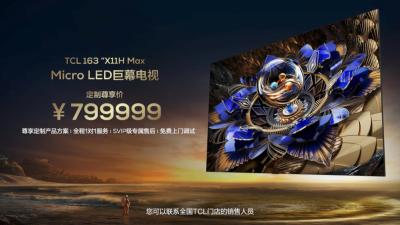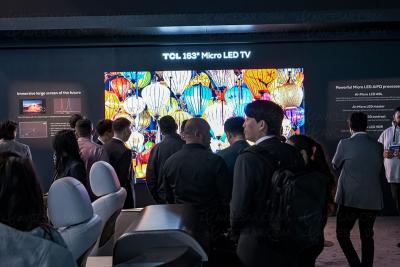MicroLED technology is a next-generation emissive display technology that promises highly efficient and bright displays that offer superior image quality with infinite contrast and a wide color gamut.
MicroLED can be applied to displays of many kinds - from small displays for smartwatches and AR devices to large-area TV displays.
Tiled MicroLED TV displays
One unique feature of microLED technology is the ability to create seamless large-area displays made from small display tiles. This unique feature is interesting because it can creates extremely large displays in which the cost grows linearly with display size, unlike standard LCD and OLED TV displays which grows exponentially more expensive as display grows.
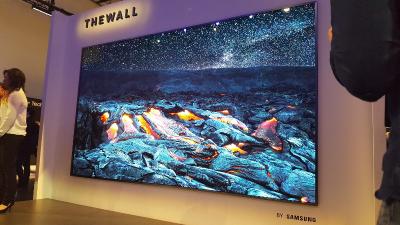
The Wall by Samsung
Several companies developed such tiled display technology, including Sony, Samsung, Konka, LG and others. Tiled large-area microLED TVs are available on the market today, but prices are very expensive and these are highly premium devices. Are you looking to buy such a TV? Check out our 2021 MicroLED TV buying guide. Not much has changed from 2021, as microLED TVs are still extremely expensive ($100,000 and over).
One interesting thing to note is that while most so-called microLED TVs are indeed emissive displays, the actual LED chips inside these TVs are not always miicroLEDs, but sometimes actually mini-LEDs (this is true for example in Samsung's TVs, at least for the first-gen models).
Consumer MicroLED TVs
Companies are also developing consumer-grade MicroLED TVs. The main challenge is bringing the cost down by a factor of around 100X, even if targeting the premium consumer TV market. Producing such consumer MicroLED displays at competitive prices is a huge challenge due to the extreme number of microLED chips - a 4K TV requires almost 25 million individual microLED chips - and these need to be produced on a wafer and transferred to the final TV substrate.
It will likely take many years before consumer MicroLED TVs at affordable prices can be produced.
Reports suggest Samsung and LG are slowing down their microLED business plans
According to reports from Korea and Taiwan, both Samsung Display and LG Display have decided to slow down their microLED business plans. The main reasons behind this are the high production costs of microLEDs and high competition which is seen to lead to low profitability.
Samsung Display will continue to invest in microLED R&D, but has delayed plans to expand production. LG Display has already reduced the size of its microLED R&D teams and is looking into deploying some of its microLED developers into the OLED side of its business.
Samsung launches 89-inch and 101-inch microLED TVs
Samsung Electronics launched two new MicroLED TVs, in sizes 89-inch and 101-inch. Samsung's "consumer" microLED TV range now includes 89", 101", 110” and 114" sizes.
The price of the 89-inch model is $110,000, and the 101-inch model costs $130,000. Samsung's largest consumer MicroLED TV costs $150,000 at 114-inches.
TCL CSOT shows its latest MicroLED prototypes at Displayweek 2024
At Displayweek 2024, TCL CSoT demonstrated its impressive 163-inch 4K (0.9375 mm pitch) tiled MicroLED display on show, that offered very high brightness (10,000 nits).
TCL says that the display has a 'nanosecond' response time, and its lifetime rating is over 100,000 hours. This is TCL's X11H Max commercial MicroLED TV, priced at $110,000.
Samsung launches a $130,000 114" microLED TV in Korea
Samsung Electronics launched a new 114" microLED TV in Korea, with a price tag of 180 million Won (about $132,600).
Interestingly, a couple of months ago Samsung introduced four new microLED TVs in China, including the 114-inch model, but it quoted a price of $173,000 - or about 30% higher than the price in Korea.
Samsung launches its 2024 microLED TV lineup in China, with a new $90,000 76-inch model
Samsung Electronics held a press event in China, launching its 2024 microLED TV lineup (in addition to its QLED and OLED TV ranges). The 2024 microLED TV lineup includes four 4K TV sizes, ranging from 76- to 114-inch.
Samsung says that it improved its microLED TV technology, offer enhanced contrast (using a new unexplained technology called 'micro-contrast technology') and color accuracy. The microLED TVs offers built-in 6.2.2 Dolby Atmos sound, and Samsung's latest NQ8 AI Gen 3 AI chipset. Interestingly, Samsung published the retail price of its microLED TVs:
TCL launches a commercial 163" MicroLED TV, the X11H Max, priced at $110,000
Chinese TV producer TCL announced its first commercial microLED TV, the 163-inch 4K TV X11H Max. The TV offers an XDR peak brightness of 10,000 nits, 22bit+ color depth, extremely fast response speed (nanosecond level) and a lifetime of over 100,000 hours. The price is set at 799,999 Yuan, or around $110,000.
This is obviously an ultra-premium product, but it is great to see TCL formally enter the microLED market. TCL first demonstrated a prototype 163" microLED panels back in 2023. It is likely that this new tiled TV features an Oxide-TFT (IGZO) backplane.
Hilton Waikiki Beach installs a 146-inch Samsung The Wall microLED display
Hilton Waikiki Beach in Hawaii installed a new 146-inch Samsung The Wall microLED display in the lobby bar. The hotel management chose the high-end display in an effort to enhance the guest experience while attracting more local foot traffic.
The hotel's howner says that the stunning visual clarity and unparalleled contrast convinced him to adopt the new microLED display. The 146-inch screen will be used to show sports, news or videos of island scenery.
TCL shows a tiled 163" microLED display prototype
TCL has demonstrated a 163" microLED TV display prototype. This seems to be the same display showed at IFA 2023 last year.
We do not have any more technical details. In May 2023, TCL unveiled a small tiled display (18.8"), this could be based on the same tiles. The 2023 display featured a pixel-pitch of 0.43 mm, an IGZO backplane and a peak brightness of 1,200 nits. CSoT says that the LED chips have an area of 400 squm, which means chip size of about 20 microns.
Konka shows a massive 310" 4K-Plus microLED display
At CES 2024, Konka is demonstrating a massive 310" microLED display. The display offers 4K-Plus resolution (Konka did not detail the exact resolution), low reflectivity (<5%), 800 nits of brightness, high refresh rate (not detailed) and a large color gamut (85% BT.2020).
Konka says that this display uses the company's self developed and fully proprietary microLED chips. Konka produces its microLED chips using Aixtron's MOCVD systems.
AUO to demonstrate a 108-inch microLED TV display in 2024
AUO announced that it will demonstrate a 108-inch residential microLED TV during ISE Europe 2024 (January 30, 2024). As far as we know, this is the first time that AUO shows a large-area microLED display. The screen is most likely a tiled microLED display.
Last month AUO announced its plans to invest further in its microLED technologies, and re-iterated its plans to mass produce microLED smartwatch displays by the end of 2023 - and also to introduce automotive and TV displays. You can read more about AUO's microLED wearable display project here.
Pagination
- Page 1
- Next page
